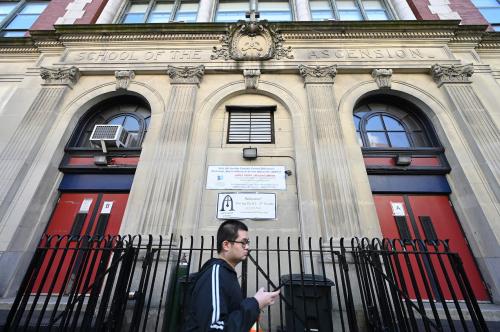This post was updated on July 6, 2023 to reflect clarifications on a cited publication.
Last month, Virginia became the 13th state to remove unnecessary degree requirements for hard-to-fill roles in state government. This trend of tearing the “paper ceiling” is being implemented by Democratic and Republican leaders alike, and speaks to the critical need to rethink our standard hiring practices in a labor market that is not allowing workers to reach their full potential. A shift to skills-based hiring instead of degree-based hiring is not only a sensible public sector reform to find qualified workers in a tight labor market—it can also unlock economic mobility for millions of workers who have been overlooked for decades.
In the last year, 10 governors have followed Maryland’s lead in issuing executive orders focused on skills-based hiring, and three states have passed legislation on it. With these actions, many states are reviewing roles to determine which ones have unnecessary degree requirements. Others, including Pennsylvania and Virginia, have already removed degree requirements from 90% of state jobs. No matter the approach, these actions are low-cost ways to open state hiring processes to more applicants and improve economic mobility for qualified workers who have been largely excluded from state hiring systems.
With the removal of degree requirements, these 13 states are addressing a critical issue: Good government jobs are frequently out of reach for over half of the workers in the US labor market. In fact, state and local government employees hold bachelor’s degrees at higher rates (57%) than federal (49%) or private sector (36%) employees. Degree requirements significantly impact 70 million “STARs” workers who are “skilled through alternative routes” such as community college, military service, and on-the-job experience, rather than a bachelor’s degree. STARs represent the majority of U.S. workers as well as the nation’s diversity: 61% percent of Black workers, 55% of Latino or Hispanic workers, 66% of rural workers, and 61% of veterans are STARs.
Analyses by our organization, Opportunity@Work, show that more than 30 million STARs have the skills to do significantly higher-wage work, but systemic barriers prevent them from moving ahead. Employers’ increasing use of degree screens—which have been adopted mostly in a piecemeal fashion rather than by grand design—is based on two false assumptions: First, that low-wage equals low-skill, and second, that a bachelor’s degree is the only gateway to relevant skills. As a result, 70% of new jobs in the past decade are ones in which employers frequently require a bachelor’s degree. But this practice—aimed mainly to manage the surge in digital applications—has severe adverse effects on the majority of the workforce that does not have a bachelor’s degree. It compounds other barriers related to the mobility of some subgroups (such as Black STARs), manager beliefs and biases, professional networks, and a lack of access to transportation, child care, and other key services.
As one of their state’s largest employers, state governments have significant power to redefine hiring criteria and shape employment opportunities for workers. This is important at a time when critical public sector roles remain unfilled, reducing the delivery of services and operations to the public. And as states shift to evaluating workers based on skills, they can reduce the opportunity gap by opening up thousands of well-paying jobs to STARs and sending a message to everyone in the state—including other employers—that if a worker has the skills to do a job, they should have access to that job and the potential career advancement it offers.
We know that economies grow when talent is appropriately invested in and deployed. As a nation, we have our work cut out for us. Right now, it takes a STAR 30 years to reach the starting wages of a recent college graduate. In fact, over the last 20 years, degree screens have, in part, cost STARs access to 7.4 million middle- and high-wage jobs that had traditionally been filled by STARs. While a bachelor’s degree has always been and always will be a critical pathway to higher wages in the U.S. labor market, this gap belies our common belief that learning can translate into earnings. And the resulting impact is stunning: an entire generation of people who have worked for 30 years with no appreciable upward mobility.
When states remove unnecessary degree requirements from job descriptions, they open the door to millions of STARs and expand access to good middle- and high-wage jobs. This common-sense practice increases economic mobility for workers and helps the state meet its staffing needs to fulfill its obligations to its citizens. And thanks to the recent surge in federal investment, states have a once-in-a-generation opportunity to modernize their infrastructure, accelerate the clean energy transition, re-shore semiconductor manufacturing, and protect critical economic assets. As states work to meet the labor force needs to fulfill these critical efforts, they need the talents and skills of all their workers. Hiring STARs is the first step, and more states should follow the lead of their peers and tear the paper ceiling so that all workers can learn and earn to their full potential.
The Brookings Institution is committed to quality, independence, and impact.
We are supported by a diverse array of funders. In line with our values and policies, each Brookings publication represents the sole views of its author(s).





Commentary
States are leading the way in tearing the ‘paper ceiling’ and making good jobs available to workers without degrees
June 16, 2023